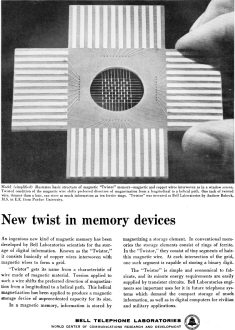February 1958 Radio-Electronics
 [Table
of Contents] [Table
of Contents]
Wax nostalgic about and learn from the history of early electronics.
See articles from Radio-Electronics,
published 1930-1988. All copyrights hereby acknowledged.
|
In another blast from
the past, I just found an advertisement by Bell Telephone Laboratories announcing
"Twistor" memory in a 1958 edition of Radio-Electronics magazine. According
to Bell, their radically new "Twistor" magnetic memory matrix was vastly superior
to conventional ferrite core memories. It used hair-thin magnetic wires (more
like a flattened tape) interwoven with equally thin copper wires to store and read
out ones and zeroes. Doing so reduced manufacturing costs, by eliminating the relatively
expensive ferrite cores and eliminating the difficult job of threading the read,
write, and sense wires through the core centers. Twistor memory also required less
current to operate, was denser, and weighed less than core memory. Within a decade
CMOS RAM was available to replace the magnetic memory, but from a reliability standpoint,
the Apollo space program selected magnetic core memory for the manned
flights.
New Twist in Memory Devices
 Model (simplified) illustrates basic structure
of magnetic "Twistor" memory-magnetic and copper wires interwoven as in a window
screen. Twisted condition of the magnetic wire shifts preferred direction of magnetization
from a longitudinal to a helical path. One inch of twisted wire, thinner than a
hair, can store as much information as ten ferrite rings. "Twistor" was invented
at Bell Laboratories by Andrew Bobeck, M.S. in E.E. from Purdue University. Model (simplified) illustrates basic structure
of magnetic "Twistor" memory-magnetic and copper wires interwoven as in a window
screen. Twisted condition of the magnetic wire shifts preferred direction of magnetization
from a longitudinal to a helical path. One inch of twisted wire, thinner than a
hair, can store as much information as ten ferrite rings. "Twistor" was invented
at Bell Laboratories by Andrew Bobeck, M.S. in E.E. from Purdue University.
An ingenious new kind of magnetic memory has been developed by Bell Laboratories
scientists for the storage of digital information. Known as the "Twistor ," it consists
basically of copper wires interwoven with magnetic wires to form a grid.
"Twister" gets its name from a characteristic of wire made of magnetic material.
Torsion applied to such a wire shifts the preferred direction of magnetization from
a longitudinal to a helical path. This helical magnetization has been applied to
produce a magnetic storage device of unprecedented capacity for its size.
In a magnetic memory, information is stored by magnetizing a storage element.
In conventional memories the storage elements consist of rings of ferrite. In the
"Twistor," they consist of tiny segments of hair-thin magnetic wire. At each intersection
of the grid, one such segment is capable of storing a binary digit.
The "Twistor" is simple and economical to fabricate, and its minute energy requirements
are easily supplied by transistor circuits. Bell Laboratories engineers see important
uses for it in future telephone systems which demand the compact storage of much
information, as well as in digital computers for civilian and military applications.
Bell Telephone Laboratories World Center of Communications Research and Development
Posted January 28, 2022
(updated from original post on 1/14/2014)
|









